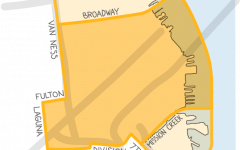
Woman refueling car at gas station using a fuel nozzle. (Photo: Hrytsiv Oleksandr/Shutterstock)
VMT Rears its Ugly Head Again as ‘Congestion Pricing’ in LA
‘The aim is to change commuter behavior with the charges while providing transit alternatives’
By Thomas Buckley, May 30, 2023 2:04 pm
So the Los Angeles Times ran a story today all about possible “congestion pricing” schemes coming soon to certain roads in the LA area soon.
While the article lauds the social engineering aspect of the concept – even quoting one expert saying “LA needs to stop pandering to automobile drivers” – the Times story literally never mentions either the downsides or how congestion pricing or vehicle miles traveled (VMT) taxes work in practicality.
Here is the story. If you hit the paywall, it’s almost worth signing up for the dollar-a-month digital promo to be able to read the exact opposite of a proper news story.
Due to that egregious oversight, we at the Globe thought it would be a good idea to let the public know what the idea actually entails.
First, the basics. A VMT involves charging a driver a fee when they drive on a particular street, or in a particular area, or at a particular time of day – or all three combined (for an in depth look at the possibilities, see HERE).
LA Metro is reportedly looking at pilot programs that would charge drivers on the 10 from downtown to Santa Monica, people driving around downtown, and folks going up and over the hills to get to the Valley. There are no set fees at this time, but these three zones embody each of the three main concepts – downtown would be the particular area, or “cordon,” the 10 would be the particular road, and to and from the Valley could be a combination of all three.
For example, the much touted “cordon” pricing systems in London and Stockholm charge a fee when you enter a certain part (that part keeps growing for some reason) of the city. In London, it’s about $18 to drive around in the city center between 7 a.m. and 6 p.m. on a weekday. Also, if you happen to not have an “Ultra Low Emission” vehicle (ULE’s are currently defined, if its gas powered, as being built relatively recently though it is more detailed than that) you will get dinged an additional $15 for the day and that applies in an area much larger than the congestion price. And the zone will expand in August, which is a typical feature of VMTs – they start small but metastasize over time.
In Stockholm, the system pings a car each time it enters or leaves the downtown area and charges a time-dependent amount. For those who get charged multiple times, it does have a daily cap of about $12.
New York City is about to institute a similar cordon program, potentially soon charging between $10 and $15 if you want to drive below 60th Street in Manhattan. The justifications include reducing traffic, cleaning the air, and, of course, “Promoting equity by providing expanded access to the transit system.”
All of these fees – and the potential LA fee – use the revenue earned – IN THEORY – to improve public transit options so people will not have to drive as much and, therefore, the roads will be less congested and safer. As we all know, you can drive a regulatory truck through anything in the name of “safety.”
Stockholm – and Singapore, which also has a system – have seen some rise in public transit usage since the imposition of the fee, a fact used by proponents to tout the concept.
What local proponents fail to mention is that neither Stockholm nor Singapore’s public transit systems are dangerous, crime-ridden, rolling shelters for the homeless, the addicted, and/or the mentally ill that make other riders fear for their lives – hence the steep drop in ridership.
Short of assigning every Metro passenger their own bodyguard – or giving them pepper spray or at least a stick or something – LA transit ridership will not increase any time soon.
All of that makes this statement from a Times editorial about two weeks ago in support of the idea even more delusional:
However, a toll can quickly change behaviors and traffic patterns. The price can make people reevaluate the trip. Is there an alternative, like taking the bus or train? Is it possible to travel in off-peak hours or avoid the trip altogether? It takes just a small percentage reduction in the number of cars to ease congestion.
It is also noted that not everyone will be paying the same fee in LA, as “low income” discounts are an integral part of the program in order to not “price out” poorer residents with no alternatives means of transport.
How this will be accomplished – will Metro have to coordinate with the IRS? Shudder – or will another metric be used to determine who qualifies for the discount is unclear.
As to those people who live in a cordon, it is unknown yet if they will be able to drive around their own neighborhood without having to pay a fee or, like in London, will they also be given a discount? The discount is high – 90% – but it still means paying extra to live in a neighborhood; how that will impact businesses and housing opportunities in the potential downtown cordon area, for example, is unclear.
Also unclear – the report will be out in August, though! – is how any fee will be charged. The most logical idea is to put transponders in people’s cars that will track where and when they drive to accurately calculate the fee (could be a monthly statement, the transponder could be linked to a debit card, etc.)
That idea – the government tracking you every time you get in the car – is a civil rights and privacy nightmare and so far has been one of the biggest political stumbling blocks to implementation in the United States. Even the LA Times article admits any VMT would face political hurdles, but it does not say what they are or why they might be publicly problematic.
So to encapsulate the political issues – most people don’t want to pay more to drive, most people do not trust the government to do what they say they will with the money, and almost no one wants every trip they take to be recorded by a government agency.
These are not mere “political” issues as the Times sniffily dismisses them – they are at the core of the bedrock American ideal of being able to travel freely without government intervention.
Already, in San Diego County, pro-VMT electeds have been tossed from office and even the regional planning agency there had to cut the idea from its future projections (but they maybe didn’t really even though the board told them to but that’s another story.)
But that does not seem to matter, as the story states quite simply – not an expert quote or anything, simply a statement of “the sky is blue” fact – that “The aim is to change commuter behavior with the charges while providing transit alternatives.”
In case you were wondering, the state is also very on board with the concept. This is an excerpt from the “Infrastructure Investment and Jobs Act (IIJA) Implementation – Reimagining Highway Investments Sub Working Group, (April, 2022) Kickoff Meeting Agenda:”
- Recent policy and planning have allowed us to really think about how we are investing in our highway systems in terms of climate and equity goals that provide benefits and reduce harm for disadvantaged communities to Improve travel and accessibility
- Shift away from single occupant vehicle use by providing competitive alternatives to driving
- A big question to think about is how do we maximize benefits while advancing equity, environmental, climate, health, and safety goals? Building new lanes or adding on to highway systems is more of a last resort strategy – instead we are focusing on developing more creative strategies that aim to improve travel and promote multi-modal approaches (emphasis added.)
You can find the entire report HERE.
Another issue with a larger VMT (local, area specific pilot programs are merely the first step) is borders, if it is expanded to cover everyone everywhere as a “revenue-neutral replacement” (I do public relations work and even I have no idea how that lie is going to be sold to the public) for the current taxes people pay at the pump.
For example, if California has a statewide VMT, how do drivers from Nevada, which may not have a statewide VMT, pay a tax? Conversely, what happens when you drive to Vegas and need to use your last $37 dollars to buy gas there for the trip home?
Luckily, the Biden administration may have already passed a solution for that pesky problem. From this recent article on the development:
In the Biden infrastructure bill signed last year, a relatively obscure bit calls for all new cars built after 2026 to have a “kill switch.” Sold as a way to combat drunk driving, the system would involve various unclear-at-the-present technologies (no blowy tubes so, yes, your car will have to be able to literally watch and presumably smell you) to detect whether or not you could be impaired and if the car determines that to be that case then the car won’t start.
Per usual, the proponents of the bill claim that no nefarious future actions are possible. From an AP story dispelling the myth of the “kill switch” (serious water carrying there) Robert Strassburger, president and CEO of the Automotive Coalition for Traffic Safety, said any information collected will “never leave the vehicle.”
In other words, it’s not really a “kill switch” and safe drivers really don’t have to worry ever and we’re doing this for your own good and anyone who thinks this device will ever be used in any other way by any government agency is nuts and bad and crazy and might be a domestic terrorist.
We’ve seen this movie before.
What proponents do not care to emphasize is the fact that the car must “passively” monitor the vehicle and driver and that the system will have at least one port of entry for someone (or something) outside the vehicle to access the system, a port of entry that will be perfect for the imposition of a national, borderless VMT.
The Biden administration also has other pilot programs in the works regarding congestion and/or VMT taxing concepts.
So, in case anyone asks you about the Times story, feel free to show them this.
You can’t say we’re not trying.
- Benefit Fraud Problems and Solutions - November 7, 2024
- A Little Exit Poll - November 5, 2024
- Tomorrow’s Headlines Today! - November 5, 2024





Actually, The Cult (my term for these deep state globalist technocrats) now has the perfect tool to enforce a VMT and much, much more. That tool is artificial intelligence. Equip every vehicle with cameras, microphones, and its own AI. That AI can then be “trained” to observe the behavior of the driver and passengers to decide if they may be incapacitated or if there are other problems. It can also be taught to keep track of and report mileage, location, any traffic violations, and to restrict and report any attempts to travel to ‘restricted’ locations. Welcome to the Brave New World.
There is a REASON why we locals with a brain call it the LA SLIMES…
Nonsense like this is continually pushed and never goes away. Always seems as though it is intended to madden and distract us. It is nothing but another tax-and-control scheme. The best thing I can think to do is write a pointed letter to my L.A. County Supervisor. I suppose I should be grateful that my supervisor listens and will speak up against it.
Thank you, Thomas Buckley, for covering this with the necessary specifics so we can understand what is really going on.
California is already a state with the lowest personal freedom. Why not have even less freedom? And they wonder why people are moving out of this state in droves. If large amounts of your money that you worked hard for is taken away from you by government, you are not free. If the government does not let you move about freely, you are not free.
I would love to hear how Newsom spins this with one of his ridiculous ads in Florida.